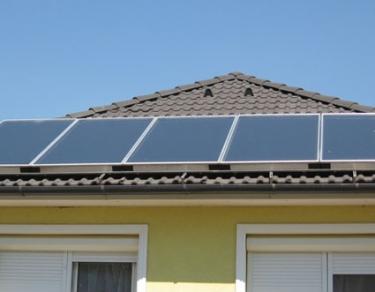
Photovoltaics, commonly known as PV, converts the solar energy in sunlight into electrical energy with a system producing no air pollution and using almost no moving parts. They are extremely reliable with a 25 year warranty and a 40 year design life.
Solar modules, groupings of special silicon cells, produce a DC (direct current) electrical charge when the cells are struck by solar energy. The DC current is routed to a device called an inverter that changes it into the AC (alternating current) electricity required by most household and business applications.
The result is a clean and reliable energy alternative for either residential or commercial use. A PV system can be integrated into a new construction project or installed on an existing building. Typically, PV modules are mounted on rooftops but they can also be mounted on the ground, on a nearby roof such as a shed or detached garage, or even incorporated into a shade structure.
PV systems used to power buildings fall into four basic categories:
“Grid-Tied” or Grid-Interconnected PV
These systems are the most popular and use special inverters to allow electricity to flow safely back into the electric grid. When solar power is generated, surplus electricity can actually flow back into the grid after the power for the building is used. Depending on your utility company, you can be given up to full retail credit per kilowatt-hour. Since there are no batteries, these systems cannot store energy and are designed to shut down if the grid is down.
“Grid-Tied” or Grid-Interconnected with Battery Back-up
These systems offer customers continued power when the grid goes down, while still being connected to the grid, for seamless power. Newer systems also accept other power sources, in addition to PV, such as wind or even traditional gas-powered generators to provide power and/or charge the battery at night and/or if the grid is not available.
“Off-Grid” PV
Useful when a completely independent or “stand alone” system is needed. Since no grid power is used, the system must be carefully designed based on power usage, peak demand and seasonal solar variations. Batteries are typically used to provide power at night, in low sun or high electric demand conditions. These systems are ideal for remote locations where no utilities exist.
Utility-Scale PV
Sometimes called “solar farms,” they provide power for regional users by, or in cooperation with, electric utility providers.
The tipping point has changed for cost-effectiveness of Solar PV systems. If your electric bill averages $120 or more per month, it makes 100% sense to install a PV system. There are numerous financing options including PACE loans where even with the interest it is still cheaper to install a PV system. Think of it this way. Would you rather pay your Utility provider monthly or pay a bank loan for the same amount of money which adds value to your home and locks in today's rates for the next 20-30 years?
Take advantage of generous solar financial incentives – Two sources combine to help you pay for your home’s photovoltaic solar system. The Federal Tax Credit has been extended through 2020 which gives homeowners a one-time tax credit equal to 30%- of the total cost of the system. The total cost of the system can include a new roof and main electrical panel upgrade is they are needed. There are also rebates from utility providers but they are disappearing quickly.
